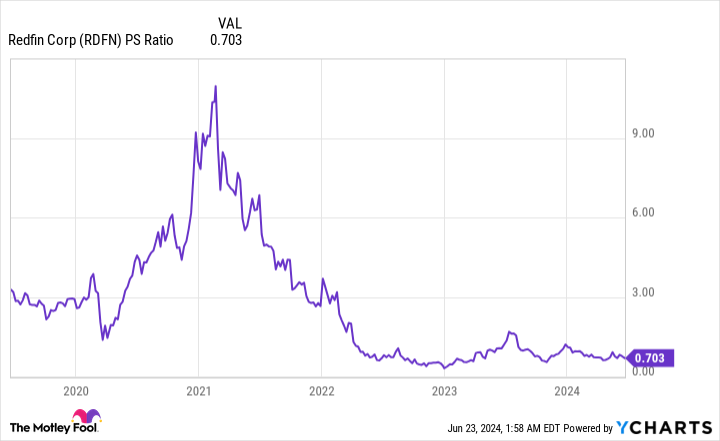In June 2022, the Consumer Price Index (CPI) measure of inflation hit an annualized rate of 9.1%, which was the highest level in 40 years, and far above the U.S. Federal Reserve’s target of 2%. To bring it down, the Fed aggressively hiked the federal funds rate from a historic low of 0.25% all the way to 5.50%.
The housing market has been a big casualty of that policy shift. Rising interest rates can reduce the borrowing capacity of the average homebuyer, which often leads to fewer sales. In fact, U.S. existing home sales came in at an annualized rate of 4.1 million units in May, which is 38% below the 2021 peak of 6.6 million units, when interest rates were sitting at record lows.
Real estate technology company Redfin (NASDAQ: RDFN) operates one of the largest brokerages in America, covering 98% of the entire geographic market. Unsurprisingly, its business cratered in the wake of soaring interest rates and slowing home sales, sending its stock down by 93% from its all-time high.
But Wall Street is forecasting two interest rate cuts from the Fed by the end of 2024, which could be the spark Redfin shares need to stage a recovery. Here’s why now might be the ideal time to buy the stock.

Redfin adjusted its business to survive the real estate winter
Redfin’s business used to have two distinct parts. There was direct buying (iBuying), which involved the company buying homes from willing sellers and flipping them for a profit. The other part was real estate services, which included its brokerage division. In 2022, iBuying made up more than half of Redfin’s total revenue, but the company decided to close the segment down that year as soaring interest rates threatened to derail the housing market.
Profit margins were razor thin in the iBuying business, so any decline in the value of Redfin’s property inventory could have triggered blowout losses. Now, the company is focusing on its services segments, which include its brokerage business, rental marketplace, title services, and mortgage lending. They carry much higher gross profit margins, and that’s helping Redfin clean up its bottom line (which I’ll discuss more in a moment).
During the first quarter of 2024 (ended March 31), Redfin’s 1,658 lead agents helped the company represent 0.77% of all U.S. home sales. Redfin charges a listing fee of just 1.5%, which is far below the industry standard of 3%. That falls to 1% if the seller also commits to buying their next home using Redfin. As a result, over one-third of its Q1 transactions came from returning customers.
Plus, a record-high 30% of customers who bought a home through Redfin during March also used its mortgage service, which is helping the company earn more revenue from each transaction.
Revenue growth is stagnant, but profitability is in sight
Redfin generated $225.5 million in revenue during the first quarter of 2024, which was a 5% increase from the year-ago period. While that sounds like a modest jump, any growth is a win considering the plunge in existing home sales I mentioned earlier.
During this tough period, Redfin is focusing on cutting costs and positioning its business for survival until conditions improve. That includes a new compensation plan for some agents who are forgoing their salaries to earn higher rates of commission instead.
Redfin’s preferred measure of profitability is adjusted EBITDA (non-GAAP earnings before interest, taxes, depreciation, and amortization), which was still negative to the tune of $27.6 million in Q1. However, it represented progress from the negative $63.6 million result during the same quarter last year.
Management says Redfin could generate $2 million in positive EBITDA in the current second quarter (ending June 30), and it also expects a positive full-year result. The company only has $107 million in cash on its balance sheet, so achieving that profitability milestone will be really important. With that said, it is holding a further $165 million in loans on its balance sheet, which it intends to sell and convert into cash.
Late last year, Redfin also refinanced some of its debt and extended its maturity to 2027, which reduces its risk of facing a cash crunch.
Redfin stock is trading at a rock-bottom valuation
Following the steep decline in its stock price, Redfin now has a market capitalization of just $720 million. Considering Wall Street thinks the company will generate over $1 billion in revenue this year, that puts its price-to-sales (P/S) ratio at just 0.7.
In other words, the housing market is currently so weak that investors value Redfin at less than one year’s worth of revenue. For perspective, they valued the company at more than 9 times its annual revenue just three years ago:
One of Redfin’s peers in the real estate technology industry, Zillow Group, trades at a P/S ratio of 5.5 right now despite also shrinking its business and generating very little growth lately. Redfin’s valuation looks unjustifiably low by comparison.
The CPI declined to a much more manageable annualized rate of 3.3% in May, and while that’s still above the Fed’s target of 2%, many Wall Street analysts believe its downward trend is clear enough for the central bank to start cutting rates. The CME Group‘s FedWatch tool predicts one cut of 25 basis points in September, followed by another in December. Cuts could gather momentum in 2025 if inflation continues to fall.
I think it’s very difficult to make an argument for Redfin’s rock-bottom valuation right now. The real estate industry should experience a wave of activity from homebuyers as soon as rates begin to fall, which will almost certainly lift Redfin’s business. Investors willing to buy Redfin stock ahead of that shift could position themselves for an extended period of gains.
Should you invest $1,000 in Redfin right now?
Before you buy stock in Redfin, consider this:
The Motley Fool Stock Advisor analyst team just identified what they believe are the 10 best stocks for investors to buy now… and Redfin wasn’t one of them. The 10 stocks that made the cut could produce monster returns in the coming years.
Consider when Nvidia made this list on April 15, 2005… if you invested $1,000 at the time of our recommendation, you’d have $775,568!*
Stock Advisor provides investors with an easy-to-follow blueprint for success, including guidance on building a portfolio, regular updates from analysts, and two new stock picks each month. The Stock Advisor service has more than quadrupled the return of S&P 500 since 2002*.
*Stock Advisor returns as of June 24, 2024
Anthony Di Pizio has no position in any of the stocks mentioned. The Motley Fool has positions in and recommends Redfin and Zillow Group. The Motley Fool recommends CME Group and recommends the following options: short August 2024 $11 calls on Redfin. The Motley Fool has a disclosure policy.
1 Super Stock Down 93% to Buy Before the Fed Cuts Interest Rates was originally published by The Motley Fool
Source Agencies


